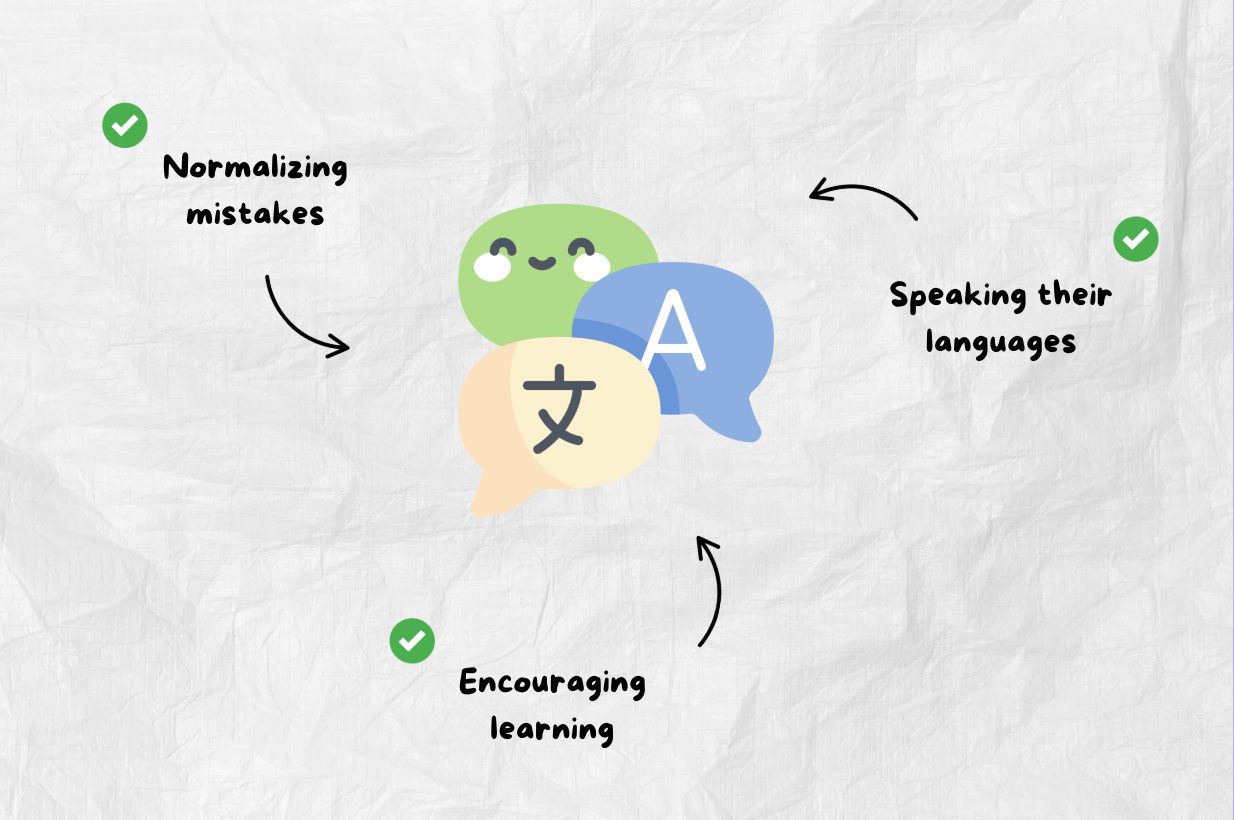5.5. Lead with Compassion - Case Study on Overcoming Language Challenges
How to Master Building Trust with Empathy and Compassion. Plus Case Study on Using Language Skills to Build Trust from Adler Hsieh. + 🎁 Building Trust Bundle.
What You'll Learn:
💡 Ways to lead with empathy and compassion
💡 Practical strategies for creating psychological safety
💡 How to build trust across language barriers
Language was the first barrier I found when I moved to AWS in Berlin.
I still remember my exhaustion after 5 hours of interviews. I started to mix Spanish words in the very last hour. To my surprise, I got hired. But during my probation, the senior engineer told me I needed to improve my English skills. He gave me some tips to follow, and after the probation period, the company paid me for English lessons. How did I improve? Controlling my emotions by not feeling discouraged. I studied and practiced more with my English teacher, who helped me land AWS, my dream job.
What is Empathy and Compassion
Empathy is caring about our coworkers, feeling with them, and wanting to help them. We are open to change our perspective while being focus in the purpose and not where to go or battle to win. It allows us to connect. However, it may cloud our judgment, encourage bias, and make us less effective at making wise decisions.
Compassion occurs when we take a step away from the problem and ask ourselves how we can really help. Then we act to overcome the challenges.
How To Master Leading With Compassion
Notice: Slow down. Observe team dynamics. Stay aware of communication challenges and watch for signs of frustration or hesitation. When focused on something, don’t lose awareness of everything else. Noticing can prevent you from making careless mistakes and enable you to become a present and engaged leader.
Understand: Seek the perspective of others by asking direct questions to understand them. Thank them for answering. Sometimes answering questions that allow us to understand them requires vulnerability, so create safe spaces.
Act: Look for ways to help to overcome the pains or challenges of your team. These compassionate acts might bring a smile or prevent burnout, even your own. Remember that some problems just need to be heard and acknowledged. Just listening or coaching can help them to find their own solution and grow.
This is what
from applied successfully with Peter. He helped Peter to overcome his language challenges through psychological safety. He normalized mistakes and fostered learning from each other. With psychological safety, Peter felt valued, and his team was encouraged to address language problems, take risks, and help others. Read his story below.Adler, over to you:
As a foreigner living in Japan, the language barrier is always a challenge for me. The working environment here is usually a mix of Japanese and English, and neither is my first language.
Since I deal with it every day, I never expected language learning to be a tool for building trust as a leader. But one of my team members, Peter (not his real name), gave me that opportunity. It was unexpected, but it worked out better than I imagined.
Let me share how language learning can be surprisingly useful for leaders.
Language Barriers and Conflicts
Peter was my team member, and he didn’t have a great relationship with others. There were constant conflicts.
When I took over the team as the Engineering Manager, I quickly realized that the team didn't like Peter. The biggest complaint I heard was that he could come hostile out of nowhere. This has been bothering the team for a while.
The first thing I did was try to understand the root cause. After talking to him and other members, I found a mix of factors:
He treated people differently depending on whether he saw them as "friends."
He was overly insistent on certain design principles and coding styles.
It seems like there are a lot of issues to work on. But luckily, I found one easy entry point that allowed me to build trust with him.
Both of us are non-native English speakers, and I noticed that he struggled to express himself accurately. His words often sound blunt or rude, but it was mostly because he couldn't find the right expressions. As someone who has also learned English as a second language, I understand how frustrating that can be.
Empathy is a choice. And it’s a vulnerable choice, because if I were to choose to connect with you through empathy, I would have to connect with something in myself that knows that feeling. — Brené Brown
For example, once someone asked him a question: “Hey, Peter. Has that feature X been deployed?”
He replied: “Yes. Do you have a problem with that?”
That sounds rude. However, what Peter wanted to say was: “Yes. Is there any issue with feature X that I can help with?”
His colleague misunderstood and thought Peter was being hostile again, leading to another conflict.
I asked Peter about his struggles with English and whether he found it difficult to express himself. I also offered to help correct any unclear or misleading phrasing when I noticed it. He was happy to accept, and from then on, we worked on this every week in our 1-on-1s.
He still had conflicts with others from time to time, but it became easier for him to listen when I stepped in. Since we had already built trust, discussions about improvements were smoother.
Creating a Language-Friendly Workspace
That experience with Peter helped me develop a few more strategies. Most of them are aligned with core leadership principles. The following is how managers can help create a language-friendly team environment:
Normalize Language Mistakes
Language learners make mistakes all the time.
You probably have run into the following situation: a foreigner tried to explain something in your native language, they struggled, and you started to lose your patience.
The same thing happens in the workplace. Everyone’s busy, and slow communication can kill productivity.
But this is where your leadership skill comes in. Leaders should create an environment where people are free to make mistakes. Language is a skill, just like coding. Working with language learners is like working with junior engineers. When they make mistakes, you help them learn, and you encourage everyone to do the same. It creates a healthy and positive environment.
And for those who don’t want to make the effort? You can include it in the feedback. Everyone should contribute to building a healthy team environment, including the language learners themselves.
Speak Their Language
If you live in a foreign country like I do, learning the local language helps not just in daily life but also in the workplace.
People give you more respect when you try to speak their language, even if you're not very good at it yet.
Speaking a foreign language in team meetings can be intimidating, and using it in casual conversations could be awkward too. In my experience, 1-on-1 meetings are the easiest place to start.
Here’s how I usually approach it:
I ask if they’re okay with me trying to speak their language. I also let them know I’d like to try it once or twice as an experiment. This gives both of us a way to adjust or stop if it doesn’t work.
When I speak, I try to use the easiest words and grammar. This minimize the risk of misunderstanding.
When listening, I clarify anything that I don't understand. And I skip the parts that don't seem important, because there's no way I'll understand everything.
And yes, sometimes conversations get stuck. When that happens, I switch back to English, write down what did't work, and study it later.
Trust me. You will earn a ton of respect, and you will see your own improvement quickly.
Encourage Learning
Depending on the language setup in the workplace, language learning can be a powerful tool for building trust. Leaders should encourage team members to learn the main communication language if they are still in the process.
Mastering a language takes time, but demonstrating a willingness to learn is a great help. The following section will explore how to demonstrate a positive learning attitude as a language learner.
Building Trust as a Language Learner
It’s much more challenging for language learners like Peter who struggle to express themselves.
As someone who has gone through the same process, I've found the following actions helpful in building trust early on:
Be Clear about the Learning Process
At an early stage, communicate the idea that you're still learning the language. This helps set the context that some mistakes may simply be due to the language barrier.
Learning Through Actions
Show a learning attitude and actively learn. For example, during one-on-one meetings, write down points you struggled to understand or express. At the end of the meeting, take a moment to ask your manager or team member about those points. This reinforces that you're actively learning, while also giving them an opportunity to support you. Through these interactions, it becomes easier to build trust and integrate language learning into the team dynamics.
Be Consistent
Avoid merely stating that you're learning without taking concrete actions. It's easy to forget language learning when work demands increase. However, if you don't actively work on it, people may forget, and they might not factor the language barrier into consideration during potential conflicts.
Final Thoughts: Language as a Leadership Skill
As a leader, it’s important to remember you don’t need to be good at everything, including languages. You don’t need to be fluent in all the languages your team speaks.
Instead, leadership is about enabling others, so language is a tool to build trust and understand the team better. You can create an environment where people feel safe making mistakes, and encourage everyone else to help. These helps build a culture with diversity, empathy, and compassion.
Have you ever worked in a foreign country and had to learn the language? I’d love to hear about your experience in the comments. — Adler Hsieh
Special thanks to
for sharing his building trust story in this 3rd milestone of the Thriving Challenge. Follow him in . In the 4th milestone, we will talk about Collaboration with and wonder leaders.🎁 Before we drop I have a gift for you!
This FREE product will help you build psychological safety and trust in your team.
Answer and Tell us: ”What are some empathic actions you would like to start/continue doing?”
Ask Me Anything: Ask your questions about building trust, drop them in the Chat or Discord.
My Recommendations
Tools
WonderLead Building Trust Bundle for free for Wonder Leaders.
Assess your team’s psychological safety and use the sheets as tools or to track progress on building trust.
Books
Unleashing the Power of Emotional Intelligence Paperback — Daniel Goleman
The Fearless Organization — Amy C. Edmondson
Against Empathy: The Case for Rational Compassion — Paul Bloom
Crucial Conversations: Tools for Talking When Stakes are High — Joseph Grenny
Self Awareness Side Thriving🌟Challenge Practice
Stop Cognitive Distortions with Blue Dolphins
If we believe that our thoughts and feelings are true, it risks our self-motivation and self-esteem. Instead of turning off negative self-talk (White Bears), get mindful and make thoughts and emotions work for you with “Go-to” positive thoughts you find inspiring (Blue Dolphins).
There are 10 types of White Bears (Cognitive Distorsions): 1) All or Nothing Thinking, 2) Overgeneralization, 3) Mental Filter, 4) Discounting the Positive, 5) Jumping to conclusions, 6) Magnification, 7) Emotional Reasoning, 8) “Should” Statements, 9) Labeling, and 10) Personalization and Blame.
Create blue dolphins 🐬 to conquer your white bears 🐻❄️!!
If you identify a cognitive distortion, defuse it by naming your feeling:
“I’m noticing I’m having the thought that [thought] that makes me feel [feeling].”Reframe by 1) reinterpreting (they might have unmet needs), 2) reordering (will you care in 1 day/month/year?), 3) repositioning (how can this make me a better leader?), or 4) normalizing (it’s ok to feel anxious/overwhelmed..)
Dive deep and keep a log in your journal 1) the thought you had (white bear), 2) its new reframed version (blue dolphin), and 3) the why and reframing technique used.
Get in Touch
You can find me on LinkedIn and X.
If you wish to make a request on a particular topic you would like to read, you can reply or send me an email to patri@develagora.com.
My English teacher died a year after I got to AWS because of cancer. I miss her a lot.
I dedicate this post to her and all of you who do your best to achieve your dreams.







Beautiful last words 🥹
Thanks you both for the insightful post.
Curious, what is your first language, Adler?